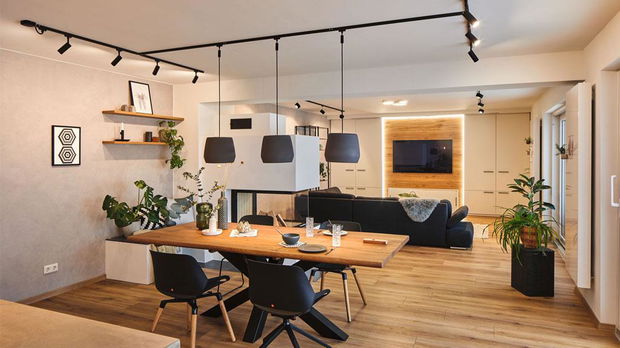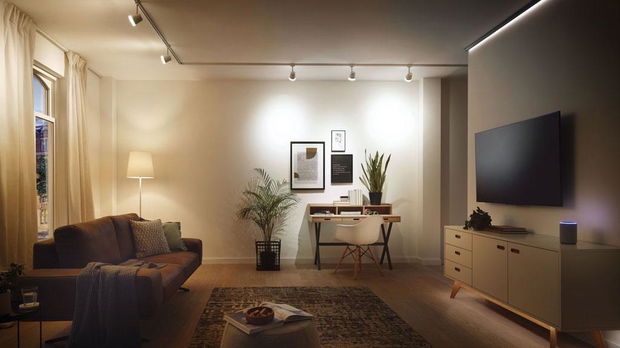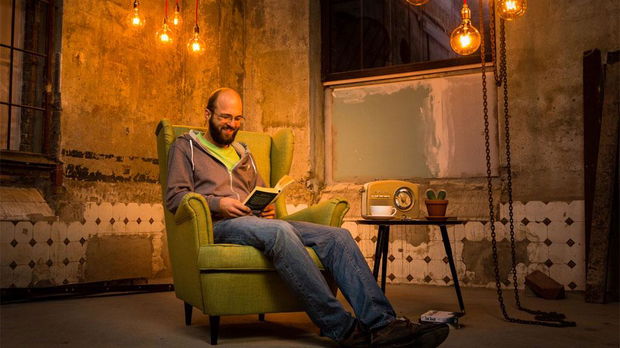You can look up the following terms:
- Accent lighting refers to the deliberate aiming of individual luminaires at specific objects in a room. It creates individual focal points and strong contrasts in lighting. Narrow beam luminaires are used for accent lighting, e.g. recessed or surface-mounted ceiling luminaires. These can be point light sources, for example halogen light bulbs, low/mains voltage and LEDs. The luminaires should be individually adjustable, as objects can be moved around in a room.
- General lighting or basic lighting refers to the uniform and planar illumination of a living space. The light is not directed, i.e. it illuminates the entire room without accentuating any objects.
- The beam angle (°) denotes the angle at which the lamp emits its light (only in reflector lamps). The smaller the beam angle, the greater the light focus and therefore the candela value. Candela (cd) is the measurement unit for luminous intensity (luminous flux per solid angle).
- In general lamps, a tungsten filament spiral is heated to about 2,500°C by the lamp's current. The high temperature of the spiral results in a visible glow (light). The lamp's interior is filled with gas or contains a vacuum to prevent the tungsten filament from burning.
A
- Illuminance (lux) is the amount of light that strikes a surface. Illuminance is described by the luminous flux of a lamp in lumen (lm), relative to the illuminated surface in m².
- Motion sensors monitor movement within a set range. That is why these components are practical for switching on lights. There are motion sensors that react passively to heat (also known as PIR, IR or proximity switch), or actively with high-frequency wave movements (HF sensors). Motion sensors usually additionally feature an integrated twilight switch.
- The illumination level describes the average light intensity in a room or at various locations. The illumination level depends on the emitted light of the luminaires and the reflective characteristics of the surfaces in the room.
B
- The CE label documents conformity with the basic requirements of specific European Union directives. The CE icon is applied by the manufacturer or the importer on the luminaire, the packaging or the accompanying documentation.
- The beam angle (°) denotes the angle at which the lamp emits its light (only in reflector lamps). The smaller the beam angle, the greater the light focus and therefore the candela value. Candela (cd) is the measurement unit for luminous intensity (luminous flux per solid angle).
C
- DIN VDE 0100 is a German installation directive for the creation of electrical systems with a rated current up to 1,000 V. Part 701 of DIN VDE 0100 describes the installation requirements for rooms with a bathtub and shower.
- Dimming is a type of lighting control. A dimmer is used to control the luminous flux of a lamp. Find out more about this topic here.
- A twilight switch actuates a lamp depending on the prevailing ambient light. The light is switched off again, once a (in some devices) configured time has elapsed.
- Direct lighting means that the light of a luminaire is directed onto illuminated objects. Unlike indirect lighting, where the light reflects off surfaces like ceilings and walls before it reaches the illuminated objects.
D
- The energy label standardises the labelling for energy efficiency. It clearly displays the energy efficiency class and offers additional information to aid your purchase decisions regarding energy-saving bulbs.
- In accordance with EU regulations, compact fluorescent lamps may be designated as energy-saving lamps, provided they fulfil special energy efficiency requirements. Energy-saving lamps feature an integrated electronic ballast.
- Discharge lamps contain two electrodes with an intermediate gas filling, which lights when a specific voltage is applied. We differentiate between high-pressure discharge lamps (sodium vapour, mercury vapour and halogen-metal vapour lamps) and low-pressure discharge lamps (fluorescent lamps). Only low-pressure discharge lamps (fluorescent lamps, compact fluorescent lamps) are used in residential applications.
- In accordance with EU regulations, compact fluorescent lamps may be designated as energy-saving lamps, provided they fulfil special energy efficiency requirements. Energy-saving lamps feature an integrated electronic ballast.
- The ENEC symbol (European Norms Electrical Certification) is a European inspection and certification symbol for luminaires and electrical components in luminaires and other products. The symbol signifies product conformity with current European standards. Audits are carried out by relevant test institutes to verify compliance in manufacturing operations. The ENEC symbol is displayed in combination with an ID number of the national test institute along with the institute's logo.
- Lamps are sub-divided into energy efficiency classes. Energy efficiency is rated on the specified light output (luminous flux, unit of measure lumen) per watt consumed. The energy efficiency class 'A++' designates very good energy efficiency, whereas 'E' signifies low energy efficiency.
- German abbreviation for electronic ballast. Electronic ballasts are particularly efficient in comparison with low-loss and conventional ballasts.
E
- The light colour of a lamp is described by the term "colour temperature". The unit of measure for colour temperature is Kelvin (K). Colour temperatures up to 3,300 K are warm white. Neutral white spans between 3,300 K and 5,300 K, while anything above 5,300 K is described as daylight white. Find out more about this topic here.
- Wetroom luminaires are luminaires with a higher protection classification that are designed to prevent moisture entering the interior of the luminaire (min. IP 44). As term "wetroom luminaire" may be ambiguous, their protection class is stated on the packaging. The protection class denotes the degree of protection against moisture ingress.
- Component for the mounting of bulbs (lamps) in luminaires.
- The colour rendering index (Ra) specifies how naturally colour are rendered under the given illumination. The best possible value is 100.
F
- Basic lighting or general lighting is the uniform and planar illumination of a living space. The light is not directed, i.e. it illuminates the entire room without accentuating any objects.
- Authorised test centres use the GS mark to confirm the conformity of a product with the Equipment Safety Act. The GS mark must only be used in conjunction with the mark of the test centre. This is a valid mark in Germany. Test centres include TÜV - (Technical Inspection Agency), the VDE Institute (Institute of the German Electrical Engineering Association) and more.
G
- Lamps with a tungsten filament spiral that contain a special gas fillings, e.g. halogens.
- Halogens are chemical materials that are extremely reactive. When used in lamps, halogen can significantly extend the service life of the lamp.
- Common term used in the lamp and luminaires industry to describe 230 V lamps or luminaires.
- The noble gases used in the Halo+ technology inside the bulb allow a higher temperature of the filament, as they dissipate less heat. The Halo+ lamp can therefore emit the same amount of light as a conventional halogen lamp with lower power consumption. That is because the amount of luminous flux emitted by the lamp depends on the temperature of the filament: the higher the filament temperature, the brighter the lamp. That makes the Halo+ lamp much more efficient, while it consumes less power than a comparable halogen lamp.
H
- The protection class (IP xy) denotes the suitability of luminaires for various environments. The x refers to the protection against penetrating particles, while y stands for moisture resistance. For more information on the topic, click here.
- Light that is reflected by a room surface (wall, ceiling) after it is emitted from the luminaire, before it reaches the illuminated objects. Find out more about this topic here.
I
- Kelvin is a basic unit of temperature and a unit of measure for colour temperature. Kelvin was named after William Thomson, who was later promoted to the title of Lord Kelvin, who introduced the thermodynamic temperature scale in 1848. The colour temperature for lamps is stated in Kelvin (K).Colour temperatures up to 3,300 K are warm white. Neutral white spans between 3,300 K and 5,300 K, while anything above 5,300 K is described as daylight white. Find out more about this topic here.
- A transformer is a ballast that converts the voltage and frequency of the input voltage.
- A compact fluorescent lamp is a unit comprising of a fluorescent lamp, base, and all additional devices needed to ignite and operate the lamp reliably, which cannot be disassembled without permanent damage.
- The cold-light mirror lamp is a special type of reflector lamp. The term cold-light refers to the small fraction of heat in the radiated light. In halogen reflector lamps with cold-light coating, the heat is mostly dissipated backwards via the reflector layer.
K
- Luminosity defines the radiation output emitted by a bulb in the visual wavelength spectrum (380 nm to 780 nm). This radiation output is weighted by the spectral sensitivity of the human eye.
- Luminous intensity is determined by the luminous flux emitted by the lamp in a specific direction. Luminous intensity is measured in candela (cd). An important factor in reflector lamps that focus the light. The narrower the beam angle, the more the light is focused and the higher the luminous intensity.
- This denotes the power consumption of a device from the mains supply in Watt (W).
- The light yield (lumen per watt) denotes the economic efficiency of lamps. The more light (lumen) generated by the applied energy/wattage, the lower the costs and the better the lamp's economic values. For more information on the topic, click here.
- Lux (lx) is the unit of measure for illuminance. A point-shaped light source with an X candela luminous intensity creates exactly X lux on a vertically illuminated surface at a distance of 1 metre.In short: 1 lux (lx) equals one lumen (lm) per square metre of illuminated surface.
- Light denotes the spectrum of electromagnetic radiation visible to the human eye. This spectrum is limited by the wavelength range 380 nm (nano metres) to 780 nm. Light at a wavelength of 380 nm appears blue, and light with a wavelength of 780 nm appears red. All other colours of the spectrum lie in between these two values.
- The light colour of a lamp is described by the term "colour temperature". The unit of measure for colour temperature is Kelvin (K). Colour temperatures up to 3,300 K are warm white. Neutral white spans between 3,300 K and 5,300 K, while anything above 5,300 K is described as daylight white. Find out more about the topic here.
- Lumen (lm) is the unit of measure for luminous flux. Luminous flux is the total amount of light emitted by the lamp. Find out more about this topic here.
- A median life span value is stated for the service life of a lamp. The median life span is the number of burn hours after which 50% of a lamp installation has malfunctioned.
- Luminous flux is the total light output of a light source, weighted by the spectral light sensitivity of the human eye. The unit of measure for luminous flux is Lumen (lm). Find out more about this topic here.
- LEDs are light diodes – the abbreviation stands for "Light Emitting Diode". These electronic semiconductor components convert significantly more energy into light than into heat. In comparison with conventional incandescent lamps, they are much more economical and eco-friendly. Find out more about this topic here.
L
- Common term used in the lamp and luminaires industry to describe 12 V lamps or luminaires.
N
- These luminaires are not used for illumination as such. They create light points or strips of light to aid orientation.
O
- Reflector lamps are bulbs with a reflector that create directed light. They are also referred to as PAR lamps.
- Part of a luminaire or a lamp (reflector lamp) that deflects the light.
- Depending on the luminaire, you can create up to 2 million individually adjustable colours by blending the colours red (R), green (G) and blue (B); alternatively, you can set a continuous colour change.
R
- Classification of the protection against electrical shock. The protection classes are I, II and III. Protection class I features a grounding strand (cable identification green/yellow). The double insulation of protection class II is used in connection with europlugs without grounding strand. Protection class III defines devices operated with low-voltage protectors.
- The base is the part of a lamp that ensures mechanical support and provides the electrical contact for a lamp in its lamp fitting.
- SECURITY lamps are halogen reflector lamps. Unlike cold-light lamps, SECURITY lamps emit up to 80% of their radiation heat outward in the light direction. This significantly reduces temperatures in e.g. suspended ceilings equipped with recessed luminaires.
- A rail with integrated electrical conductors and allows the connection of luminaires.
- Specific defined max. voltage level and galvanic isolation to prevent electric shock (AC mains = max. 60 V, DC mains = 120 V).
S
- A transformer is used for the increase or reduction of AC voltages as well as the simultaneous galvanic separation of individual electrical circuits. The purpose of a transformer in halogen low-voltage technology is to reduce the mains voltage from 230 V to a voltage of 12 V.
T
- Uplights (also known as recessed floor luminaires or ceiling uplights) direct their light primarily upwards towards the ceiling; where adjustable reflectors are used, they can also be directed at a point of the wall near the ceiling. From there, the light is reflected and indirectly illuminates the room.
U
- A ballast is a device that adjusts the mains voltage to the required lamp voltage. With LED products, ballasts are referred to as "drivers" if they generate a constant current (variable output voltage), and as "power supply" if they generate a constant DC voltage.
- Inspection mark of the VDE Institute.
V
- Physical unit of output.
W
- We carry various types of die-cast luminaires in our product range. An aluminium-zinc alloy (Zamac) is used as their base material. These materials are more corrosion-resistant than steel, and are therefore suitable for use in wetrooms.








